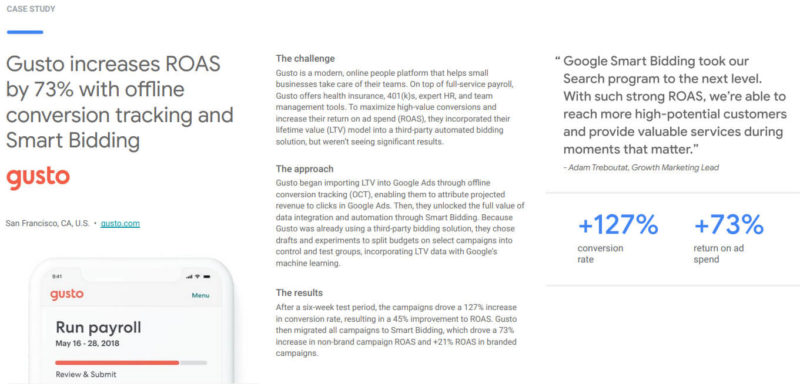Automation puts new capabilities at our fingertips, but success will remain out of reach if you don’t take an active role in guiding those advancements.
Unfortunately, there’s little to be done about the data or controls that platforms take away, but there is something we can do about how we perceive these advancements. At SMX Create, Carolyn Lyden and I presented a keynote on the ways automation has changed search marketing and how marketers must learn to use these tools and understand our role with respect to them if we want to maintain a competitive advantage.
You’re probably already used to automation
The capabilities that AI and machine learning bring to your business range from minor automations, such as visualizing your internal links or personalizing ads using data feeds, to natural language processing, like GPT-3, that can write content or ad copy for you based on a sprinkling of inputs.
On the organic side, many marketers have automated keyword-focused SEO tasks like rank tracking and monitoring for brand mentions. There are also tools that will analyze SERPs for you, tell you about search volume, how competitive a keyword is and the assumed intent behind it. The right combination of these tools, and more importantly, knowing when to use (or ignore) the information they’re giving you, can help you determine the type of content to create as well as how detailed that content should be.
The paid search professionals among us have had a long history of adapting to automation introduced by platforms, dating back to the deprecation of “pure” exact match keywords. And, now that responsive search ads are the default in Google Ads, it’s more important than ever for marketers to understand what their role is with respect to the technology that powers their campaigns.
Automation still requires guidance
Going full-steam ahead with automation may be a tempting idea, especially for teams that are short on resources, but the technology is still a long way away from understanding the entire scope of your marketing efforts. And to some extent, that’s probably how it’ll always be.
For instance, keyword and SERP analysis tools may help you narrow down which queries to target, and you can plug that data into another tool to automatically generate the content, but the technology just isn’t sophisticated enough to publish without an experienced professional to finetune it. Just look at The Guardian’s GPT-3-generated article — it’s quite good for something that probably did not require much human effort, but this level of content is unlikely to get you closer to your performance goals without a real marketer tailoring it to fit their audience personas, ensuring that it doesn’t cannibalize keywords, adding the appropriate internal links and so on.

On the PPC side, a “set it and forget it” attitude towards automation can result in wasted budget and effort. Using keyword match types means your ads can trigger for terms that you think are irrelevant or even harmful to your brand, and human intervention is required to get your campaign back on track. To minimize any potential blunders, marketers must also ensure that they’re providing the machines with inputs that complement each other, as is necessary with responsive search ads. In the example shown above, Google Ads rejected the ad because the advertiser didn’t provide Google’s platform with unique headlines to work with, resulting in the appearance of keyword stuffing.
Advancements in automation typically involve training models on datasets, and the larger a dataset is, the better the model typically performs. However, datasets may contain biases that are ultimately reflected in whatever the model produces, especially if the data comes from the internet. This can even be true on a much smaller scale, such as when you create a lookalike audience using a segment of your own customer data. The potential for these biases probably isn’t as obvious as wasted ad budget, but the risks here are two-fold:
- Your messaging, be it ads or organic, misses the mark with your target audience. Microsoft’s Marketing with Purpose Playbook has a great example of this: “A marketer might conclude that a luxury accessories brand should target women, because gender appears to correlate with a higher purchase probability. That might lead you to assume that only women buy luxury handbags, but gender may just be a red herring. Income could correlate with conversion to a much higher degree. The resulting bias of only targeting women would limit your opportunity.”
- Your automation behaves predictably, but there are scenarios that you didn’t account for. The apology in the screenshot below was issued when the New England Patriots’ automated social media retweeted a user’s racist handle. Microsoft’s AI chatbot, Tay, was another example of an unforeseen scenario.
 100vw, 671px” data-lazy-src=”https://searchengineland.com/wp-content/seloads/2021/04/patriots_apology.png” /></figure>
</div>
<p>However, marketers aren’t simply stewards of the technology they use. Our role, with respect to the automation available to us, is far more nuanced.</p>
<h2 id=) What your relationship with automation should be
What your relationship with automation should be
As automation continues to entrench itself in every aspect of search marketing, it may be easy to become apathetic towards it or even resent how these developments change our workflows. Not all changes are going to be positive, but many will be necessary, and any reluctance in adapting to them will put you at a disadvantage. Below is a framework that can help you stave off that inertia and take stock of your role as a marketer in an increasingly automated industry.
Chart a course. Successful automation requires clear business objectives, just like any other aspect of marketing. Setting those objectives is likely up to your C-suite, but coordinating the strategy to get there is up to you. Before any automation can be applied, you must talk to stakeholders, set the campaign goal and determine what’s important to measure along the way.
Fuel the machine. The inputs you provide have a huge influence on the quality of the outputs your automated tools produce. You may already be doing this by adding negative keywords to your PPC campaigns or manually adjusting your SEO crawling or SERP-scraping options, for instance.

Automation, especially with regards to PPC, often requires marketers to meet a data threshold in order for it to function the way it was intended — pay close attention to what the platforms recommend and how your campaigns are performing as you adjust your inputs. In the example above, HR management software company Gusto integrated offline conversion tracking into the data it was feeding to Google Ads, which ultimately enabled the company to increase their conversion rates and improve ROAS.
Guide the campaign. Automation has been likened to cruise control but that analogy may downplay how important it is to keep your eyes on the road. Whether it’s due to a global pandemic, a competitor’s new strategy, a dramatic shift in audience priorities or just seasonality, marketers must know when to turn off or recalibrate their automated systems.
Google’s updated phrase match is a great example of this. If your keywords were previously broad match modified, that announcement had a substantive impact on your account structure, and you had to go off of cruise control to reconfigure your keywords for phrase match’s new treatment.
Coordinate your data and efforts. We’re at a point where platforms are so confident about their machine learning capabilities that they’re making recommendations. But, their ability to provide us with useful insights has yet to catch up, and even if it did, those insights would be drawn from a slice of your overall marketing efforts because platforms, like Facebook and Google, aren’t going to talk to each other on your behalf.
Your campaigns don’t exist in a vacuum: They’re susceptible to the environment you’re marketing in and what you’re doing in any given channel should complement what you’re doing in other channels. It’s still on you, as the marketer wielding the automation, to tie together data and information from disparate sources and create a cohesive journey for your customers.
Automation is advancing, so should you
The technological advancements we’ve seen in our industry lay a lot of capabilities at our fingertips, but campaign success will remain out of reach if you don’t take an active role in guiding those advancements. Remember, automation isn’t here to take your job, but it will change the nature of your work and being cognizant of that evolving relationship will help you get the most out of what’s available to you.
Special thanks to Carolyn Lyden, Andrew Shotland, Brad Geddes, Christi Olson, Fred Vallaeys, Ginny Marvin, Julie Bacchini, MJ DePalma and Noah Learner for helping me put these ideas together for my keynote at SMX Create, which served as the basis for this article.


